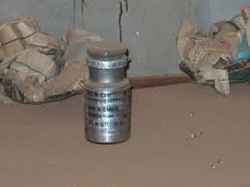Tuesday, April 12, 2016
Naturally occurring radioactive material from the aluminium industry--a case study: the Egyptian Aluminium Company, Nag Hammady, Egypt.
The activity concentrations and the gamma-absorbed dose rates of the terrestrial naturally occurring radionuclides (226)Ra and (232)Th were determined in samples of bauxite, alumina and aluminium dross tailings industrial waste (used to produce two types of alums) using high purity germanium (HPGe) gamma ray spectrometry. The bauxite and alumina are imported by Egyptalum (The Egyptian Aluminium Company, Nag Hammady, Egypt) from Guinea and India. The activity concentrations in the bauxite range from 29 +/- 1 to 112 +/- 6 Bq kg(-1) for (226)Ra, and 151 +/- 8 to 525 +/- 12 Bq kg(-1) for (232)Th, with mean values of 62 +/- 8 and 378 +/- 50 Bq kg(-1), respectively. With respect to alumina and tail, the mean values are 5.7 +/- 1.1 and 8.4 +/- 0.8 Bq kg(-1) for (226)Ra and 7.2 +/- 1.6 and 10.7 +/- 1.2 Bq kg(-1) for (232)Th. Potassium-40 was not detected in any of the studied samples. The measured activity concentrations of (226)Ra and (232)Th in bauxite are higher than the world average while in alumina and tail they are lower. As a measure of radiation hazard to the occupational workers and members of the public, the Ra equivalent activities and external gamma dose rates due to natural radionuclides at 1 m above the ground surface were calculated. The external gamma-radiation doses received by the Egyptalum workers are 97, 409, 8.5 and 12.7 microSv y(-1) for the Guinean and Indian bauxite, the alumina and tail, respectively, which is well below the recommended allowed dose of 1 mSv y(-1) for non-exposed workers.
http://www.ncbi.nlm.nih.gov/pubmed/17146126
http://www.ncbi.nlm.nih.gov/pubmed/17146126
So, we have here "red mercury" discovered by the soviets in 1968!!! of course all over world labs sell it under restricted orders!!! However, this chemical is also supllied under another name, antimony III oxide, however, its also called "Technetium (/tɛkˈniːʃiəm/) is a chemical element with symbol Tc and atomic number 43. All of its isotopes are radioactive"
and special used as..... " technetium-99m is a metastable nuclear isomer of technetium-99 (itself an isotope of technetium), symbolized as 99mTc, that is used in tens of millions of medical diagnostic procedures annually, making it the most commonly used medical radioisotope."
and special used as..... " technetium-99m is a metastable nuclear isomer of technetium-99 (itself an isotope of technetium), symbolized as 99mTc, that is used in tens of millions of medical diagnostic procedures annually, making it the most commonly used medical radioisotope."
TRANSPORTATION OF THE "DIRTY CAKE"
as you see here, the ionization is almost complete with alumminum lead, but there's still the alpha particles.which needs therefore this gunn diode for emission of negative frequencies

The negative differential resistance, combined with the timing properties of the intermediate layer, is responsible for the diode's largest use: in electronic oscillators at microwave frequencies and above. A relaxation oscillator can be created simply by applying a DC voltage to bias the device into its negative resistance region. In effect, the negative differential resistance of the diode cancels the positive resistance of the load circuit, thus creating a circuit with zero differential resistance, which will produce spontaneous oscillations. The oscillation frequency is determined partly by the properties of the middle diode layer, but can be tuned by external factors. In practical oscillators an electronic resonator is usually added to control frequency, in the form of a waveguide, microwave cavity or YIG sphere. The diode is usually mounted inside the cavity. The diode cancels the loss resistance of the resonator, so it produces oscillations at itsresonant frequency. The frequency can be tuned mechanically, by adjusting the size of the cavity, or in case of YIG spheres by changing the magnetic field. Gunn diodes are used to build oscillators in the 10 GHz to high (THz) frequency range.
Gallium arsenide Gunn diodes are made for frequencies up to 200 GHz, gallium nitride materials can reach up to 3 terahertz.[
Subscribe to:
Comments (Atom)





